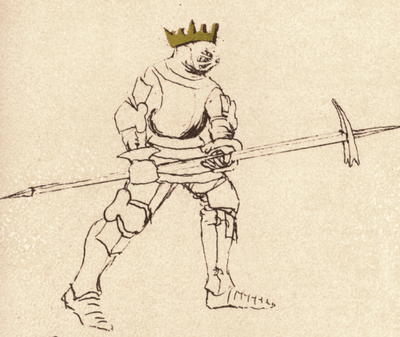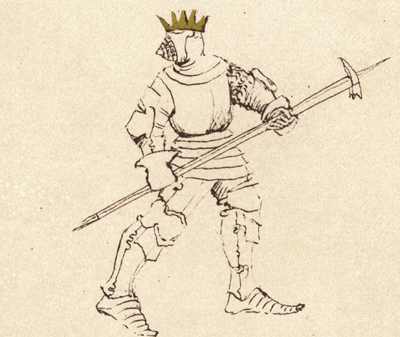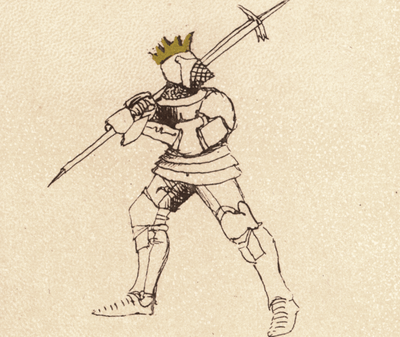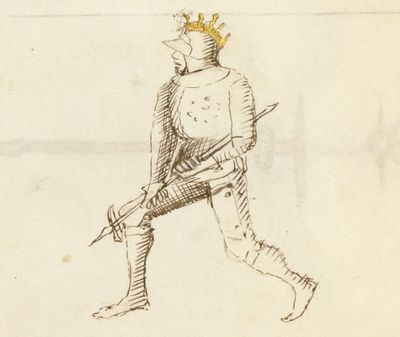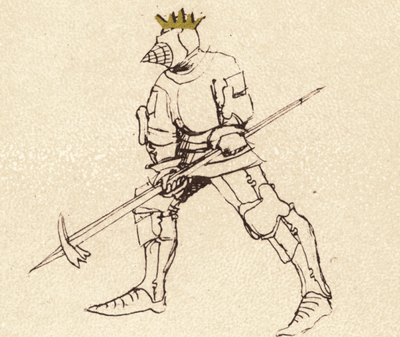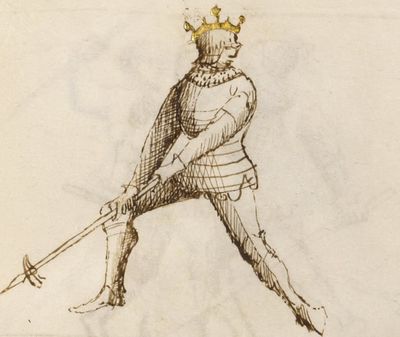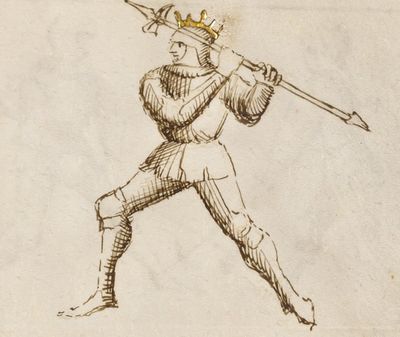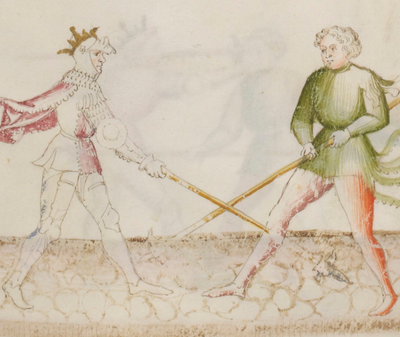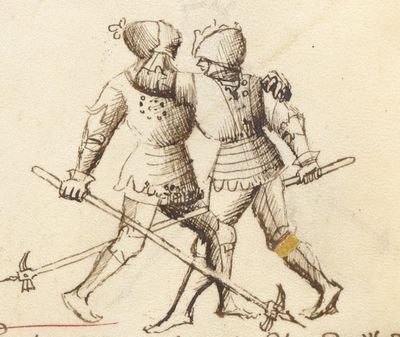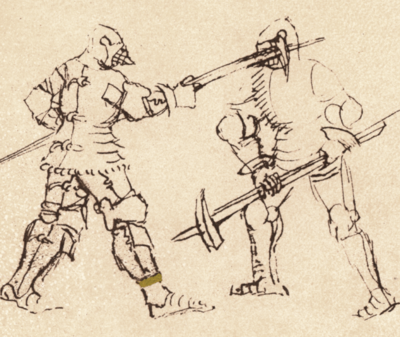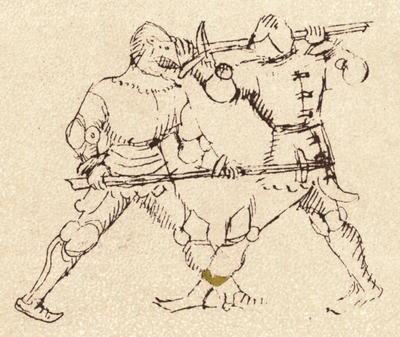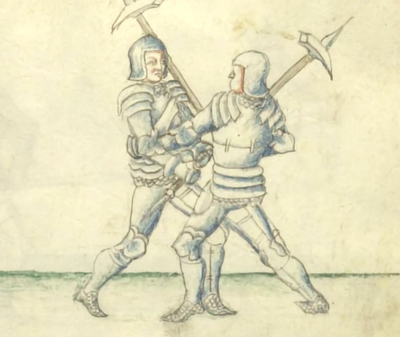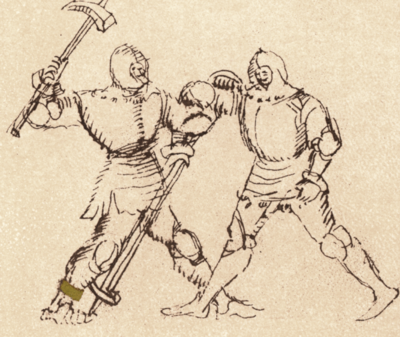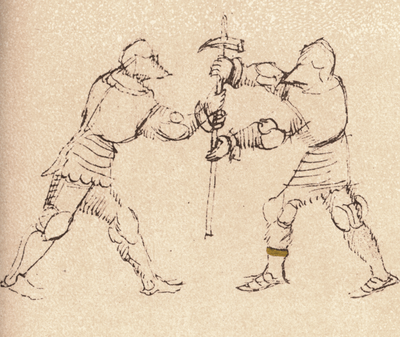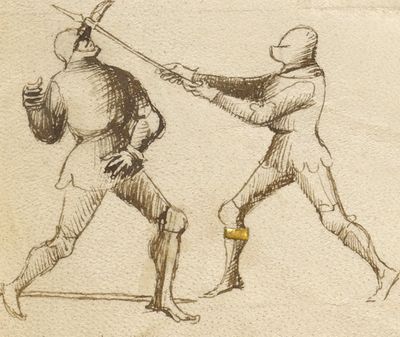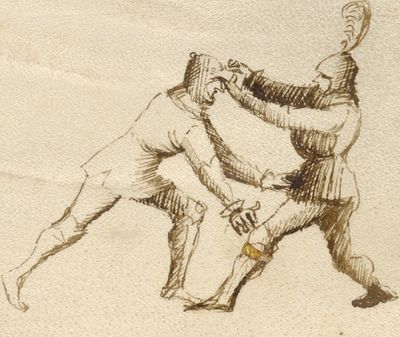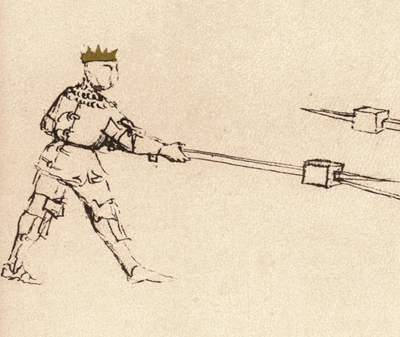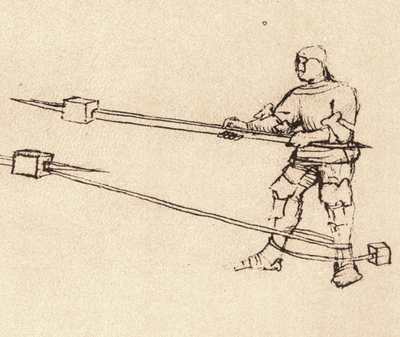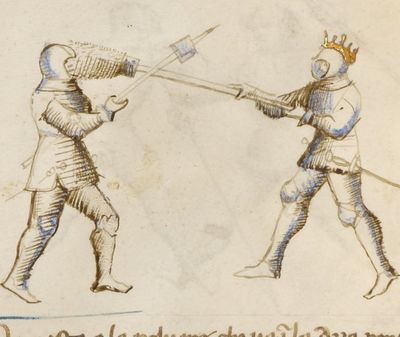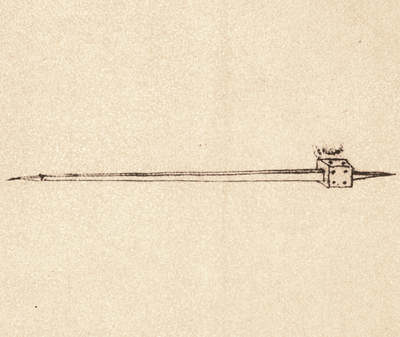|
|
You are not currently logged in. Are you accessing the unsecure (http) portal? Click here to switch to the secure portal. |
Difference between revisions of "Fiore de'i Liberi/Poleaxe"
| (20 intermediate revisions by the same user not shown) | |||
| Line 1: | Line 1: | ||
| − | <noinclude><div style="width: | + | <noinclude><div style="width:240em;"></noinclude> |
| − | {| class=" | + | {| class="master" |
|- | |- | ||
| − | ! <p> | + | ! <p></p> |
| − | ! <p> | + | ! <p>Illustrations</p> |
| − | ! <p>''{{rating|B| | + | ! <p>''{{rating|B|Novati Translation}} by [[Michael Chidester]]''<br/>{{rating|B|Getty Translation}} by [[Colin Hatcher]]</p> |
| − | ! <p>''{{rating| | + | ! <p>''{{rating|C|Paris Translation}} by [[Kendra Brown]] and [[Rebecca Garber]]''<br/>{{rating|B|Morgan Translation}} by [[Michael Chidester]]</p> |
| − | ! <p>[[ | + | ! <p>[[Trattato della scherma (MS M.383)|Morgan Transcription]] (1400s){{edit index|Trattato della scherma (MS M.383)}}<br/>by [[Michael Chidester]]</p> |
| − | ! <p>[[Fior di Battaglia (MS Ludwig XV 13)|Getty Transcription]] | + | ! <p>[[Fior di Battaglia (MS Ludwig XV 13)|Getty Transcription]] (1400s){{edit index|Fior di Battaglia (MS Ludwig XV 13)}}<br/>by [[Michael Chidester]]</p> |
| − | ! <p>[[Flos Duellatorum (Pisani Dossi MS)|Pisani Dossi Transcription]] | + | ! <p>[[Flos Duellatorum (Pisani Dossi MS)|Pisani Dossi Transcription]] (1409){{edit index|Flos Duellatorum (Pisani Dossi MS)}}<br/>by [[Michael Chidester]]</p> |
| − | ! <p>[[Florius de Arte Luctandi (MS Latin 11269)|Paris Transcription]] | + | ! <p>[[Florius de Arte Luctandi (MS Latin 11269)|Paris Transcription]] (1420s){{edit index|Florius de Arte Luctandi (MS Latin 11269)}}<br/>by [[Kendra Brown]] and [[Rebecca Garber]]</p> |
|- | |- | ||
| | | | ||
| − | | [[File:Pisani-Dossi MS | + | | [[File:Pisani-Dossi MS 27a-a.png|400px|center]] |
| − | | | + | | <p>[1] {{red|b=1|The Stance of the Shortened Serpent}}</p> |
| − | + | ||
| + | <p>''I am the Shortened Stance, the Serpent, with axe in hand;<br/>If my thrust does not miss, I will made trouble for you.<br/> ''</p> | ||
| − | < | + | <p>I am the Short Serpent Guard and I consider myself better than the other guards. And whoever receives one of my thrusts will bear the scars.<ref>Fiore literally says “will be marked”.</ref> This guard delivers a powerful thrust that can penetrate cuirasses and breastplates. Fight with me<ref>Fiore literally says “defend yourself”.</ref> if you want to see the proof.</p> |
| − | + | | <p><br/></p> | |
| − | |||
| − | + | <p>''Behold, with grasping hands I am called the Short Spear Position<br/>Among mortals. And if the spear point would not try to deceive,<br/>Perhaps I will deceive you, Man. Jupiter is near on a mountain.''</p> | |
| − | |||
| | | | ||
| {{section|Page:MS Ludwig XV 13 35v.jpg|lbl=-|35v-attl}} | | {{section|Page:MS Ludwig XV 13 35v.jpg|lbl=-|35v-attl}} | ||
| Line 37: | Line 36: | ||
|- | |- | ||
| | | | ||
| − | | [[File:Pisani-Dossi MS | + | | [[File:Pisani-Dossi MS 27a-b.png|400px|center]] |
| − | | | + | | <p>[2] {{red|b=1|The Stance of the True Cross}}</p> |
| − | + | ||
| + | <p>''I am the strong stance called the Cross:<br/>Neither blows of the axe nor thrusts can bother me.''</p> | ||
| − | < | + | <p>I am named the Guard of the True Cross, since I defend myself by crossing weapons, and the entire art of fencing and armed combat is based on defending yourself with the covers of crossed weapons. Strike as you wish, I’ll be waiting for you. And just as the student of the First Remedy Master of the sword in armor does, so I can do with a step and a thrust with my poleaxe.</p> |
| − | + | | <p><br/></p> | |
| − | I am | + | <p>''Behold, I am a Position of strength, and I am called the Cross. No blow is<br/>Bothersome to me, nor as yet the point of the poleaxe<ref>Literally “trident”, perhaps referring to the three striking surfaces of the weapon’s head (axe or hammer, hook, and spear point).</ref> at any time.''</p> |
| − | |||
| | | | ||
| {{section|Page:MS Ludwig XV 13 35v.jpg|lbl=-|35v-bttl}} | | {{section|Page:MS Ludwig XV 13 35v.jpg|lbl=-|35v-bttl}} | ||
<br/><br/> | <br/><br/> | ||
| + | |||
{{section|Page:MS Ludwig XV 13 35v.jpg|35v-b}} | {{section|Page:MS Ludwig XV 13 35v.jpg|35v-b}} | ||
| | | | ||
<br/> | <br/> | ||
| + | |||
{{section|Page:Pisani-Dossi MS 27a.jpg|27a-b}} | {{section|Page:Pisani-Dossi MS 27a.jpg|27a-b}} | ||
| | | | ||
<br/> | <br/> | ||
| + | |||
{{section|Page:MS Latin 11269 8v.jpg|8v-d}} | {{section|Page:MS Latin 11269 8v.jpg|8v-d}} | ||
|- | |- | ||
| | | | ||
| − | | [[File:Pisani-Dossi MS | + | | [[File:Pisani-Dossi MS 27a-c.png|400px|center]] |
| − | | | + | | <p>[3] {{red|b=1|[The Stance of the Queen]}}</p> |
| − | + | ||
| + | <p>''I am the Stance of the Queen, of pure loyalty:<br/>I make great blows from a different measure.''</p> | ||
| − | < | + | <p>I am the Guard of the Lady, and I go against the Boar’s Tusk guard. If he waits for me, I will make a powerful strike at him, in which I move my left foot off the line, and then I pass forwards, striking downwards at his head. And if he blocks strongly under my poleaxe with his, then even if I can’t strike him in his head I will not fail to strike his arms or hands.</p> |
| − | I make | + | | <p><br/></p> |
| − | + | <p>''Behold, I am pure of faith standing in the Position of the Woman.<br/>And I work deadly things by doubling a strike of strikes.''</p> | |
| − | |||
| | | | ||
| | | | ||
| Line 74: | Line 76: | ||
<br/><br/> | <br/><br/> | ||
| + | |||
{{section|Page:MS Ludwig XV 13 35v.jpg|35v-c}} | {{section|Page:MS Ludwig XV 13 35v.jpg|35v-c}} | ||
| | | | ||
<br/> | <br/> | ||
| + | |||
{{section|Page:Pisani-Dossi MS 27a.jpg|27a-c}} | {{section|Page:Pisani-Dossi MS 27a.jpg|27a-c}} | ||
| | | | ||
<br/> | <br/> | ||
| + | |||
{{section|Page:MS Latin 11269 9r.jpg|9r-a}} | {{section|Page:MS Latin 11269 9r.jpg|9r-a}} | ||
|- | |- | ||
| − | | [[File:MS Ludwig XV 13 35v-d.jpg| | + | | [[File:MS Ludwig XV 13 35v-d.jpg|400px|center]] |
| − | | [[File:Pisani-Dossi MS | + | | [[File:Pisani-Dossi MS 27a-d.png|400px|center]] |
| − | | | + | | <p>[4] {{red|b=1|[The Wild Boar's Tusk/Middle Iron Gate]}}</p> |
| − | |||
| − | < | + | <p>''I am the Boar's Tusk, full of daring:<br/>Blows of the axe can do nothing to me.''</p> |
| − | Blows of the axe can do nothing to me.</ | ||
| − | If | + | <p>If my Middle Iron Gate is opposed by the Guard of the Lady, we both know each other’s game, for we have faced each other many, many times in battle with swords and with poleaxes. And let me tell you, what she claims she can do to me, I can do better against her. Also let me tell you that if I had a sword instead of a poleaxe, then I would thrust it into my opponent’s face as follows: when I am waiting in the Middle Iron Gate with my two-handed sword, if he attacked me with his poleaxe with a powerful downward strike from the Guard of the Lady, then I quickly advance forward striking him strongly under his poleaxe as I step off the line, and then I quickly grasp my sword in the middle with my left hand and make the thrust into his face. While there is little difference between we two guards, I am the more deceptive.</p> |
| − | | | + | | <p><br/></p> |
| − | <br/> | ||
| − | <br/>< | + | <p>''I am the strong Boar’s Tooth and, horribly daring,<br/>By no means do I fear those strikes you make. It cannot be believed.''</p> |
| − | ''[The Paris image resembles the Pisani | + | <p>''[The Paris image resembles the Pisani Dossi.]''</p> |
| | | | ||
| | | | ||
| Line 113: | Line 115: | ||
|- | |- | ||
| | | | ||
| − | | [[File:MS Ludwig XV 13 36r-a.jpg| | + | | [[File:MS Ludwig XV 13 36r-a.jpg|400px|center]] |
| − | | | + | | <p>[5] {{red|b=1|[The Stance of the Long Tail]}}</p> |
| − | |||
| − | I am | + | <p>I am the Long Tail, used against the Window Guard, and I can strike at any time. With my downward strikes I can beat every poleaxe or sword to the ground, setting me up nicely for close play. As you see the plays that follow, please consider each one in sequence.</p> |
| | | | ||
| | | | ||
| | | | ||
<br/> | <br/> | ||
| + | |||
{{section|Page:MS Ludwig XV 13 36r.jpg|36r-a}} | {{section|Page:MS Ludwig XV 13 36r.jpg|36r-a}} | ||
| | | | ||
| Line 128: | Line 130: | ||
|- | |- | ||
| | | | ||
| − | | [[File:MS Ludwig XV 13 36r-b.jpg| | + | | [[File:MS Ludwig XV 13 36r-b.jpg|400px|center]] |
| − | | | + | | <p>[6] {{red|b=1|[The Stance of the Casement Window on the Left]}}</p> |
| − | |||
| − | I am | + | <p>I am named Window Guard on the left, and I am made with the right arm pulled back.<ref>Literally “I am made with a short right arm”.</ref> This is not a good guard to wait in.<ref>Literally “We do not have stability.”</ref> Everything I do is deceptive. You think that I am going to strike a downward strike, but I pass backwards and switch guards. So while I began on the left, I actually enter on the right. And I can quickly transition to the plays that follow.</p> |
| | | | ||
| | | | ||
| | | | ||
<br/> | <br/> | ||
| + | |||
{{section|Page:MS Ludwig XV 13 36r.jpg|36r-b}} | {{section|Page:MS Ludwig XV 13 36r.jpg|36r-b}} | ||
| | | | ||
| Line 143: | Line 145: | ||
|- | |- | ||
| | | | ||
| − | | [[File:MS Latin 11269 | + | | [[File:MS Latin 11269 09r-c.png|400px|center]] |
| − | | < | + | | <p>[7] <em>I have beaten your axe to the ground;<br/>And mine will quickly be thrust in your face.</em></p> |
| − | And mine will quickly be thrust in your face.</em></ | ||
| − | These are the plays that the | + | <p>These are the plays that these guards put to the test. Each guard can do them, and each guard believes it will prevail. As is drawn here, whoever beats his opponent’s poleaxe to the ground can do these plays, and will succeed as long as the opponent fails to counter him.</p> |
| − | ''[In the Getty and Pisani | + | <p>''[In the Getty and Pisani Dossi, the Master is missing his crown.]''</p> |
| − | | | + | | <p>''I will certainly throw your poleaxe down to the earth,<br/>But mine will strike the face with listless wounds.''</p> |
| | | | ||
| | | | ||
<br/><br/> | <br/><br/> | ||
| + | |||
{{section|Page:MS Ludwig XV 13 36v.jpg|36v-a}} | {{section|Page:MS Ludwig XV 13 36v.jpg|36v-a}} | ||
| {{section|Page:Pisani-Dossi MS 27b.jpg|27b-a}} | | {{section|Page:Pisani-Dossi MS 27b.jpg|27b-a}} | ||
| Line 160: | Line 162: | ||
|- | |- | ||
| | | | ||
| − | | [[File:MS Ludwig XV 13 36v-b.jpg| | + | | [[File:MS Ludwig XV 13 36v-b.jpg|400px|center]] |
| − | | | + | | <p>[8] This student puts his axe between his opponent’s legs, and covers his eyes with his left hand. When the opponent, who cannot see, tries to turn, he will surely fall to the ground.</p> |
| − | |||
| | | | ||
| | | | ||
| Line 171: | Line 172: | ||
|- | |- | ||
| | | | ||
| − | | [[File:Pisani-Dossi MS | + | | [[File:Pisani-Dossi MS 27b-b.png|400px|center]] |
| − | | < | + | | <p>[9] <em>I have come from the Boar's Tusk with my axe,<br/>And with that I have wounded you in the face.</em></p> |
| − | And with that I have wounded you in the face.</em></ | ||
| − | + | <p>The previous student can also do this play when he is at close range, as you can see here. He steps with his left foot on top of his opponent’s poleaxe head, and draws back his own poleaxe, then thrusts it into his opponent’s face.</p> | |
| − | ''[In the Getty, the Scholar's right foot is on his opponent's poleax.]'' | + | <p>''[In the Getty, the Scholar's right foot is on his opponent's poleax.]''</p> |
| − | | | + | | <p>''Now from the Boar’s Tooth and the particular poleaxe, ready I immediately sprang forth. <br/>And I pierced the face using that thing with the strength of oak.''</p> |
| − | <br/></ | ||
| − | ''[In the Paris, the Scholar wears a crown.]'' | + | <p>''[In the Paris, the Scholar wears a crown.]''</p> |
| | | | ||
| | | | ||
| Line 191: | Line 190: | ||
|- | |- | ||
| | | | ||
| − | | [[File:Pisani-Dossi MS | + | | [[File:Pisani-Dossi MS 27b-c.png|400px|center]] |
| − | | < | + | | <p>[10] <em>I have lifted your visor—you can feel it—<br/>And I will bore out your teeth with my axe.</em></p> |
| − | And I will bore out your teeth with my axe.</em></ | ||
| − | The student | + | <p>The previous student saw that it was not possible to strike his opponent in the face with his poleaxe, because his opponent’s visor is too strong. So he advances his left foot forward and lifts the opponent’s visor, and drives his point into his face with as much force as he can give to his poleaxe. You can add on this play to any of the previous plays, as well as to any of the plays which follow.</p> |
| − | + | | <p>''Lo, I press your very own face with the strong hand, and you feel that.<br/>My sacred poleaxe will now extract these, your very own teeth.''</p> | |
| − | <br/></ | ||
| − | ''[In the Paris, the Scholar wears a crown.]'' | + | <p>''[In the Paris, the Scholar wears a crown.]''</p> |
| | | | ||
| | | | ||
| Line 208: | Line 205: | ||
|- | |- | ||
| − | | [[File:Cod.1324 25r-a.jpg| | + | | [[File:Cod.1324 25r-a.jpg|400px|center]] |
| − | | [[File:Pisani-Dossi MS | + | | [[File:Pisani-Dossi MS 27b-d.png|400px|center]] |
| − | | < | + | | <p>[11] <em>Because of my hand which I have under your arm<br/>I will cause you trouble in the strong key.</em></p> |
| − | I will cause you trouble in the strong key.</em></ | ||
| − | + | <p>With this hold<ref>“Presa” means a hold, a grip or a grapple.</ref> I can strike you in the head with my poleaxe, and with my left arm I will put you in the Strong Lower Bind, which is more deadly than any other lock.</p> | |
| − | ''[These two images seem to show the beginning and end of the technique.]'' | + | <p>''[These two images seem to show the beginning and end of the technique.]''</p> |
| | | | ||
| | | | ||
| | | | ||
<br/><br/> | <br/><br/> | ||
| + | |||
{{section|Page:MS Ludwig XV 13 37r.jpg|37r-a}} | {{section|Page:MS Ludwig XV 13 37r.jpg|37r-a}} | ||
| {{section|Page:Pisani-Dossi MS 27b.jpg|27b-d}} | | {{section|Page:Pisani-Dossi MS 27b.jpg|27b-d}} | ||
| Line 226: | Line 223: | ||
|- | |- | ||
| | | | ||
| − | | [[File:Pisani-Dossi MS | + | | [[File:Pisani-Dossi MS 28a-a.png|400px|center]] |
| − | | < | + | | <p>[12] <em>I will make a quick rotation from this catch:<br/>Your axe will be lost, and mine will strike you in the face.<br/> </em></p> |
| − | Your axe will be lost, and mine will strike you in the face. | ||
| − | </em></ | ||
| − | With a | + | <p>With a half-turn of this poleaxe I will take it from your hands. And once I have taken it from you with this particular turn, I will strike you in the head with it, as the next student shows. And I do not believe you will survive this.</p> |
| − | | | + | | <p>''By means of this taking, I will possibly have made a whirling around.<br/>From here yours will be plundered, but my poleaxe will strike your forehead.<br/>In this way fate wants the strong to survive.''</p> |
| − | <br/><br/>< | ||
| − | ''[In the Paris, the Scholar's right foot is forward and he wears a crown.]'' | + | <p>''[In the Paris, the Scholar's right foot is forward and he wears a crown.]''</p> |
| | | | ||
| | | | ||
<br/><br/><br/> | <br/><br/><br/> | ||
| + | |||
{{section|Page:MS Ludwig XV 13 37r.jpg|37r-b}} | {{section|Page:MS Ludwig XV 13 37r.jpg|37r-b}} | ||
| {{section|Page:Pisani-Dossi MS 28a.jpg|28a-a}} | | {{section|Page:Pisani-Dossi MS 28a.jpg|28a-a}} | ||
| Line 245: | Line 240: | ||
|- | |- | ||
| | | | ||
| − | | [[File:MS Ludwig XV 13 37r-c.jpg| | + | | [[File:MS Ludwig XV 13 37r-c.jpg|400px|center]] |
| − | | | + | | <p>[13] This play follows on from the student before me. As he clearly told you, you will likely drop to the ground dead after being struck in the head like this. And if this blow is not enough then I can give you another. If I choose I can also drag you to the ground by your visor, which is drawn next.</p> |
| − | |||
| | | | ||
| | | | ||
| Line 256: | Line 250: | ||
|- | |- | ||
| | | | ||
| − | | [[File:MS Ludwig XV 13 37r-d.jpg| | + | | [[File:MS Ludwig XV 13 37r-d.jpg|400px|center]] |
| − | | | + | | <p>[14] I am demonstrating what the student before me said he would do to you, that is dragging you to the ground by your visor. This is a grappling technique that is one of the better ones you can do.<ref>Fiore actually writes that this grappling move is “better than the others”, but gives us no clue as to what the “others” are.</ref></p> |
| − | |||
| | | | ||
| | | | ||
| Line 266: | Line 259: | ||
|- | |- | ||
| − | | [[File:Pisani-Dossi MS | + | | [[File:Pisani-Dossi MS 36a-c.png|400px|center]] |
| − | | [[File:Pisani-Dossi MS | + | | [[File:Pisani-Dossi MS 36a-d.png|400px|center]] |
| − | | | + | | <p>[15] This play is easy to understand, and you can clearly see how I can drag him to the ground. And when I have him on the ground, I can drag him behind me. And when the long tail of my poleaxe can no longer hold him, then he’ll feel my strikes.</p> |
| − | |||
| | | | ||
| | | | ||
| {{section|Page:MS Ludwig XV 13 37v.jpg|37v-a}} | | {{section|Page:MS Ludwig XV 13 37v.jpg|37v-a}} | ||
| − | | | + | | <p><span style="font-size:85%;">[[[Page:Pisani-Dossi MS 36a.jpg|36a-cd]]]</span> [No text]</p> |
| − | <span style="font-size:85%;">[[[Page:Pisani-Dossi MS 36a.jpg|36a-cd]]]</span> [No text] | ||
| | | | ||
|- | |- | ||
| | | | ||
| − | | [[File:MS Ludwig XV 13 37v-b.jpg| | + | | [[File:MS Ludwig XV 13 37v-b.jpg|400px|center]] |
| − | | | + | | <p>[16] This poleaxe of mine is filled with a powder and is hollow and perforated.<ref>As in full of holes.</ref> And this powder is so strongly corrosive that the moment it touches your eye, you will no longer be able to open it, and you may be permanently blinded.</p> |
| − | + | ||
| + | <p>I am the poleaxe, heavy, vicious and deadly. I deliver blows more powerful than any other hand-held weapon. If my first strike misses, then my poleaxe becomes risky to hold on to and is no more of any use to me. But if my first blow is powerfully made on target, then I can stop any other hand-held weapon. And if I am accompanied with good protective armor, then I can defend myself with any of the powerful striking guards of the sword.</p> | ||
| + | |||
| + | <p>My most noble lord, my Marquis, there are some vicious things shown in this book that you would never do. I show you them purely to aid your knowledge.<ref>I believe this is not an apology for the poleaxe itself but an apology for showing the dirty trick of the corrosive powder. As such it should really be placed higher up.</ref></p> | ||
| | | | ||
| | | | ||
| {{section|Page:MS Ludwig XV 13 37v.jpg|37v-b}} | | {{section|Page:MS Ludwig XV 13 37v.jpg|37v-b}} | ||
| − | | | + | | <p><span style="font-size:85%;">[[[Page:Pisani-Dossi MS 36a.jpg|36a-b]]]</span> [No text]</p> |
| − | <span style="font-size:85%;">[[[Page:Pisani-Dossi MS 36a.jpg|36a-b]]]</span> [No text] | ||
| | | | ||
|- | |- | ||
| − | | | + | | class="noline" | |
| − | | [[File:Pisani-Dossi MS | + | | class="noline" | [[File:Pisani-Dossi MS 36a-b.png|400px|center]] |
| − | | | + | | class="noline" | <p>[17] This is the powder that you use in the poleaxe drawn above. Take the sap of the spurge,<ref>“Titimallo” refers to a plant named spurge, genus Euphorbia. Used in medieval medicine as a laxative, spurge has a poisonous milky white latex-like sap. For more information, see [http://www.fioredeiliberi.org/getty/pollaxe.html "Pollaxe in Armour"] by [[Matt Easton]] and [http://guywindsor.net/blog/2014/06/beingwrong/#sthash.2WaPuk2R.GeiEPsy0.dpbs "Being wrong can lead to wonderful things"] by [[Guy Windsor]].</ref> and dry it in a warm oven to make a powder. Now take two ounces of this powder and one ounce of powder of ''fior d'preda'',<ref>Tom Leoni notes that this is a flower also used to create a powder commonly used as makeup. It had a swelling effect on the skin.</ref> and mix them together. Now load this powder into the poleaxe shown above. You can do this with any good caustic powder, but you won’t find a better recipe than the one in this book.</p> |
| − | + | | class="noline" | | |
| − | | | + | | class="noline" | |
| − | | | + | | class="noline" | {{section|Page:MS Ludwig XV 13 37v.jpg|37v-d}} |
| − | | {{section|Page:MS Ludwig XV 13 37v.jpg|37v-d}} | + | | class="noline" | <p><span style="font-size:85%;">[[[Page:Pisani-Dossi MS 36a.jpg|36a-b]]]</span> [No text]</p> |
| − | | | + | | class="noline" | |
| − | <span style="font-size:85%;">[[[Page:Pisani-Dossi MS 36a.jpg|36a-b]]]</span> [No text] | ||
| − | | | ||
|} | |} | ||
Latest revision as of 21:32, 25 June 2021
Illustrations |
Novati Translation |
Paris Translation |
Morgan Transcription (1400s) |
Getty Transcription (1400s) |
Pisani Dossi Transcription (1409) |
Paris Transcription (1420s) | |
|---|---|---|---|---|---|---|---|
[1] The Stance of the Shortened Serpent I am the Shortened Stance, the Serpent, with axe in hand; I am the Short Serpent Guard and I consider myself better than the other guards. And whoever receives one of my thrusts will bear the scars.[1] This guard delivers a powerful thrust that can penetrate cuirasses and breastplates. Fight with me[2] if you want to see the proof. |
Behold, with grasping hands I am called the Short Spear Position |
· Posta breve serpentina ·
[35v-a] ¶ Io son posta breve la serpentina che megliore dele altre me tegno. A chi daro mia punta ben gli parera lo segno. Questa punta si'e forte per passare coraze e panceroni, deffende ti che voglio far la prova. |
[27a-a] Posta breve son la serpentina cum la aça in mano |
[8v-c] ¶ Manibus astringens Jaculum / brevis: en vocor inter | |||
[2] The Stance of the True Cross I am the strong stance called the Cross: I am named the Guard of the True Cross, since I defend myself by crossing weapons, and the entire art of fencing and armed combat is based on defending yourself with the covers of crossed weapons. Strike as you wish, I’ll be waiting for you. And just as the student of the First Remedy Master of the sword in armor does, so I can do with a step and a thrust with my poleaxe. |
Behold, I am a Position of strength, and I am called the Cross. No blow is |
· Posta de vera crose ·
[35v-b] ¶ Io son posta di vera crose, pero che cum crose me defendo. E tutta l'arte di scarmir[!] e de armizare se defende cum coverte dello armizare incrosare. Tra pur, che ben t'aspetto, che zo che fa lo scolar primo dello magistro remedio della spada in arme cum lu modo e cum lo passar tale punta cum la azza mia ti posso far. |
[27a-b] Io son posta forte chiamada la crose |
| |||
[3] [The Stance of the Queen] I am the Stance of the Queen, of pure loyalty: I am the Guard of the Lady, and I go against the Boar’s Tusk guard. If he waits for me, I will make a powerful strike at him, in which I move my left foot off the line, and then I pass forwards, striking downwards at his head. And if he blocks strongly under my poleaxe with his, then even if I can’t strike him in his head I will not fail to strike his arms or hands. |
Behold, I am pure of faith standing in the Position of the Woman. |
[35v-c] ¶ Posta de donna son contra dente zengiaro, Si ello mi aspetta uno grande colpo gli voglio fare, zoe che passaro lo pe stancho acressando fora de strada, e intraro in lo fendente per la testa. E si ello vene cum forza sotto la mia azza cum la sua, se non gli posso ferire la testa, ello no me mancha a ferirlo o in li[5] brazzi o en le man. |
[27a-c] Posta de dona son de lielta pura |
| |||
[4] [The Wild Boar's Tusk/Middle Iron Gate] I am the Boar's Tusk, full of daring: If my Middle Iron Gate is opposed by the Guard of the Lady, we both know each other’s game, for we have faced each other many, many times in battle with swords and with poleaxes. And let me tell you, what she claims she can do to me, I can do better against her. Also let me tell you that if I had a sword instead of a poleaxe, then I would thrust it into my opponent’s face as follows: when I am waiting in the Middle Iron Gate with my two-handed sword, if he attacked me with his poleaxe with a powerful downward strike from the Guard of the Lady, then I quickly advance forward striking him strongly under his poleaxe as I step off the line, and then I quickly grasp my sword in the middle with my left hand and make the thrust into his face. While there is little difference between we two guards, I am the more deceptive. |
I am the strong Boar’s Tooth and, horribly daring, [The Paris image resembles the Pisani Dossi.] |
[35v-d] ¶ Si posta di donna a mi porta di ferro mezana e contraria, io cognosco lo suo zogo e'llo mio. E piu e piu volte semo stade ale batagle e cum spada e cum azza. E si digo che quello ch'ella dise de poder fare, piu lo posso far a lei ch'ella lo po far a mi. Anchora digo che se io avesse spada e non Aza che una punta gli metteria in la fazza, zoe, che in lo trar che posta di donna fa cum lo fendente, e io son in porta de ferro mezana cum la spada a doii mane,[7] che subito in lo suo venire, io acresco e passo fora de strada, sotto la sua azza per forza io entro, E subito cum la mia man stancha piglio mia spada al mezo e'la punta gli metto in volto. Si che tra noii altro che de malicia e pocha conparacione. |
[27a-d] Dent de zenchiar son pieno de ardiment |
| |||
[5] [The Stance of the Long Tail] I am the Long Tail, used against the Window Guard, and I can strike at any time. With my downward strikes I can beat every poleaxe or sword to the ground, setting me up nicely for close play. As you see the plays that follow, please consider each one in sequence. |
[36r-a] ¶ Coda longa Io son, contra posta de Fenestra voglio fare de tutto tempo posso ferire. E cum mio colpo di fendente ogni Azza e spada in terra sbateria, E al zogo stretto, forte me faria. Come voii troverete qui gli zoghi di dredo, de guardagli a uno a uno che ven prego. |
||||||
[6] [The Stance of the Casement Window on the Left] I am named Window Guard on the left, and I am made with the right arm pulled back.[9] This is not a good guard to wait in.[10] Everything I do is deceptive. You think that I am going to strike a downward strike, but I pass backwards and switch guards. So while I began on the left, I actually enter on the right. And I can quickly transition to the plays that follow. |
[36r-b] ¶ Posta de Fenestra son chiamata la sinestra, uno picolo brazo se fa de mi ala destra. Noii non avemo stabilita. Una e l'altra cerca la falsita. tu credera che io vegna cum lo fendente, e io tornero un pe indredo e mi mudero di posta. Li che era in la sinestra, io entrero in la destra. E crezo entrare in gli zoghi che vegneno dredo ben presta. |
||||||
[7] I have beaten your axe to the ground; These are the plays that these guards put to the test. Each guard can do them, and each guard believes it will prevail. As is drawn here, whoever beats his opponent’s poleaxe to the ground can do these plays, and will succeed as long as the opponent fails to counter him. [In the Getty and Pisani Dossi, the Master is missing his crown.] |
I will certainly throw your poleaxe down to the earth, |
[36v-a] ¶ Questi sono gli zoghi delli quali le guardie fano questione. Zaschuna le vol pigliare, e crede aver rasone. Quello che po sbatter la azza dello compagno a terra come e qui depento, questi zoghi quello fazza, Tutti gli fara se lo contrario non lo impaza. |
[27b-a] La'tua aça in terra o rebatuda |
[9r-c] ¶ In terram projecta fuit tua nempe tricuspis. | |||
[8] This student puts his axe between his opponent’s legs, and covers his eyes with his left hand. When the opponent, who cannot see, tries to turn, he will surely fall to the ground. |
[36v-b] ¶ Lo scolaro ch'a'zza alo zugadore la sua azza enfra le gambe. e cum la man stancha ello gli covra la vista. E quando lo zugador non vede, e se vole voltare, tosto va in terra senza fallare. |
||||||
[9] I have come from the Boar's Tusk with my axe, The previous student can also do this play when he is at close range, as you can see here. He steps with his left foot on top of his opponent’s poleaxe head, and draws back his own poleaxe, then thrusts it into his opponent’s face. [In the Getty, the Scholar's right foot is on his opponent's poleax.] |
Now from the Boar’s Tooth and the particular poleaxe, ready I immediately sprang forth. [In the Paris, the Scholar wears a crown.] |
[36v-c] ¶ Anche lo scolaro che m'e denanzi po fare questo zogho quando ello e ale strette come veder possete Lo pe stancho pogna sopra la sua azza, e tra la sua in dredo. e la punta metta allo zugadore in la fazza. |
[27b-b] De dent de zenchiar son ensudo cum mia aza |
||||
[10] I have lifted your visor—you can feel it— The previous student saw that it was not possible to strike his opponent in the face with his poleaxe, because his opponent’s visor is too strong. So he advances his left foot forward and lifts the opponent’s visor, and drives his point into his face with as much force as he can give to his poleaxe. You can add on this play to any of the previous plays, as well as to any of the plays which follow. |
Lo, I press your very own face with the strong hand, and you feel that. [In the Paris, the Scholar wears a crown.] |
[36v-d] ¶ Lo scolaro ch'e denançi vede che cum la punta dela Azza non a possudo far niente a lo zugadore in lo volto per la visera ch'e forte. Ello acresse lo pe stancho, e levagli la visera e la punta gli mette in la fazza, cum tanta forza ch'ello po dare a la sua azza. Questo zogho che fazo seguisse quelli ch'e denançi, e poii quelli de dredo tutti quanti.[12] |
[27b-c] La tua visera t'o levada tu lo senti |
||||
[11] Because of my hand which I have under your arm With this hold[14] I can strike you in the head with my poleaxe, and with my left arm I will put you in the Strong Lower Bind, which is more deadly than any other lock. [These two images seem to show the beginning and end of the technique.] |
[37r-a] ¶ Per questa presa che io chosi te tegno cum mia Azza te feriro in la testa. e cum mio brazzo mancho ti mettero in ligadura de sotto la forte, che piu che le altre e pericolosa di morte. |
[27b-d] Per mia mane che o soto el tuo braço |
|||||
[12] I will make a quick rotation from this catch: With a half-turn of this poleaxe I will take it from your hands. And once I have taken it from you with this particular turn, I will strike you in the head with it, as the next student shows. And I do not believe you will survive this. |
By means of this taking, I will possibly have made a whirling around. [In the Paris, the Scholar's right foot is forward and he wears a crown.] |
[37r-b] ¶ Cum meza volta ti cavaro questa Azza dele mane. E tolta che io te'lla avero, in quello proprio voltare, io ti feriro in la tua testa come fa questo scolar che m'e dredo, tu cazera morto comme io credo. |
[28a-a] Per questa presa io faro una volta presta |
||||
[13] This play follows on from the student before me. As he clearly told you, you will likely drop to the ground dead after being struck in the head like this. And if this blow is not enough then I can give you another. If I choose I can also drag you to the ground by your visor, which is drawn next. |
[37r-c] ¶ Questo zogho e dello scolaro che m'e denançi che fazo, Quello ch'ello a ditto ben lo crezo che in terra cazerai morto per lo colpo che in la testa io t'o fatto. E se questo colpo non ti basta, uno altro ten posso dare, e poii per la visera in terra te voro tirare. Chome qui dredo depento, e quello ti faro se non mi pento. |
||||||
[14] I am demonstrating what the student before me said he would do to you, that is dragging you to the ground by your visor. This is a grappling technique that is one of the better ones you can do.[16] |
[37r-d] ¶ Quello che dise lo scolaro ch'e denanzi quello io ti fazzo, che per la visera in terra ti voglio zitare. E se volesse quello ti faria cum lo abrazare, che meglio che li altri, e quello so ben fare. |
||||||
[15] This play is easy to understand, and you can clearly see how I can drag him to the ground. And when I have him on the ground, I can drag him behind me. And when the long tail of my poleaxe can no longer hold him, then he’ll feel my strikes. |
[37v-a] ¶ Questo zogho e liçero de intender che ben se vede ch'ello posso in terra zitare. E quando lo sara in terra dredo me'llo voro strassinare. E quando la corda piu non lo tegnera, delle mie feride asai ello avera. |
[36a-cd] [No text] |
|||||
[16] This poleaxe of mine is filled with a powder and is hollow and perforated.[17] And this powder is so strongly corrosive that the moment it touches your eye, you will no longer be able to open it, and you may be permanently blinded. I am the poleaxe, heavy, vicious and deadly. I deliver blows more powerful than any other hand-held weapon. If my first strike misses, then my poleaxe becomes risky to hold on to and is no more of any use to me. But if my first blow is powerfully made on target, then I can stop any other hand-held weapon. And if I am accompanied with good protective armor, then I can defend myself with any of the powerful striking guards of the sword. My most noble lord, my Marquis, there are some vicious things shown in this book that you would never do. I show you them purely to aid your knowledge.[18] |
[37v-b] ¶ Questa mia Azza era piena de polvere, e si'e la ditta Azza busada intorno intorno.[19] & e questa polvere si forte corrosiva che subito come ella tocha l'ochio, l'omo per nissun modo no'l po avrire, e fuorsi maii non vedera piu. ¶ Azza son ponderosa crudele e mortale. mazori colpi fazo che altra arma manuale. E se io falisso lo primo colpo che vegno a fare, la Azza m'e di danno e niente piu non vale. E se io fiero lo primo colpo ch'io fazzo, Tutte le altre Arme manuale io cavo d'impazo. E se son cum bone arme ben acompagnada, per mia deffesa piglio le guardie, pulsative de spada. Signore nobilissimo Signor mio Marchese, assaii chose sono in questo libro che voii tale malicie non le fareste. Ma per piu savere, piazavi di vederle. |
[36a-b] [No text] |
|||||
[17] This is the powder that you use in the poleaxe drawn above. Take the sap of the spurge,[20] and dry it in a warm oven to make a powder. Now take two ounces of this powder and one ounce of powder of fior d'preda,[21] and mix them together. Now load this powder into the poleaxe shown above. You can do this with any good caustic powder, but you won’t find a better recipe than the one in this book. |
[37v-d] ¶ Questa e la polvere che va in la Azza penta qui sopra. Pigla la latte delo titimallo, e seccalo al sole overo in forno caldo e fane polvere, e piglia di questa polvere unce ·ⅱ· e una unza de polvere de Fior de preda, e mescola in sembre. e questa polvere si de metter in la Azza qui de sopra, ben che se po fare cum ogni rutorio che sia fino, che ben ne trovereti di fini in questo libro. |
[36a-b] [No text] |
- ↑ Fiore literally says “will be marked”.
- ↑ Fiore literally says “defend yourself”.
- ↑ Literally “trident”, perhaps referring to the three striking surfaces of the weapon’s head (axe or hammer, hook, and spear point).
- ↑ Added later: "quisquam".
- ↑ Corrected from "e" to "i".
- ↑ Marginal note: "+ ecce".
- ↑ The text says "a doii mane cum la spada" with symbols next to "a" and "cum" apparently indicating that it should move. Since "cum a doii mane" makes no sense, I've moved the whole phrase "cum la spada".
- ↑ This may be an error for fascis.
- ↑ Literally “I am made with a short right arm”.
- ↑ Literally “We do not have stability.”
- ↑ Added later: "scilicet subito".
- ↑ Word partially effaced.
- ↑ Added later: "+ tibi".
- ↑ “Presa” means a hold, a grip or a grapple.
- ↑ We are translating 'captura' as 'the taking' or 'the takings'. Other possible contexts for this word in Latin are from hunting (captura=prey, the fishing catch, the bag of animals brought in) or from economics, in which 'captura' refers to ill-gotten or immorally gained profits.
- ↑ Fiore actually writes that this grappling move is “better than the others”, but gives us no clue as to what the “others” are.
- ↑ As in full of holes.
- ↑ I believe this is not an apology for the poleaxe itself but an apology for showing the dirty trick of the corrosive powder. As such it should really be placed higher up.
- ↑ "intorno" appears twice, but neither is struck out.
- ↑ “Titimallo” refers to a plant named spurge, genus Euphorbia. Used in medieval medicine as a laxative, spurge has a poisonous milky white latex-like sap. For more information, see "Pollaxe in Armour" by Matt Easton and "Being wrong can lead to wonderful things" by Guy Windsor.
- ↑ Tom Leoni notes that this is a flower also used to create a powder commonly used as makeup. It had a swelling effect on the skin.

